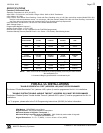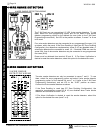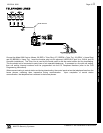
L NAPCO Security Systems
Freedom F-64 Installation Instructions
WI1501A 9/06
Page 11
WIRING CONNECTIONS
BATTERY
The RED (+) and BLACK (-) flying leads must be connected
to a 12VDC 4-7 AH Rechargeable Battery, to serve as
backup power in the event of AC Power Failure. NOTE: To
calculate the available standby time refer to the Standby-
Battery Calculation Worksheet at the back of this manual.
TRANSFORMER
(The following applies to installations in the United States of America): Connect
a 16.5 VAC Transformer to Terminals 1 and 2, using a wire of #18 AWG. or
larger at a distance of 15 ft. or less from the control panel. NOTE: Do not
connect to a switched outlet.
Connect the alarm sounding devices (self-contained sirens,
speakers or a mechanical bell) to Terminals 3 and 4. Any self-
contained siren requiring a 12 VDC input can be connected.
When connecting a mechanical bell, it must be supervised
using a 2.2k Ohm resistor. To connect 8 Ohm Speakers use a
Siren Driver with the proper polarity observed. NOTE: Refer to
the F-64 Panel Wiring Diagram for alarm current specification.
Note: In NFPA Household Fire Installations, only a single si-
ren or bell can be used on this bell circuit.
SIREN/BELL POWER
AUXILIARY POWER
Connect the auxiliary devices (motion detectors, glass breaks, etc.) to Terminals 5
and 6. Auxiliary Power provides 11.7-12.5 VDC nominal output which is used for
powering auxiliary devices. NOTE: To calculate the available standby time refer to
the Standby-Battery Calculation Worksheet at the back of this manual.
PGM OUTPUTS (PGM1 & PGM2)
PGM1 and PGM2 are negative switched
programmable outputs that can be activated
depending on the programming options
selected (see F-64 Panel Programming
Instructions). Connect the device controlled by
the programmable output between terminal 5
(+) and the PGM output (-), either terminal 7 or
8. As an example, the connection to the
RB1000 Relay Module is shown.
7
Wiring Connections: Battery, Transformer, Siren Power, Aux. Power & PGM Outputs


















